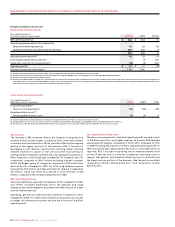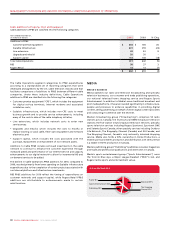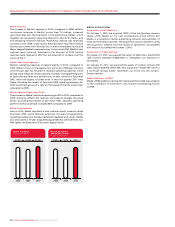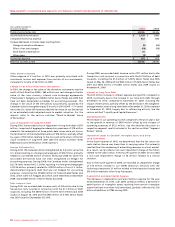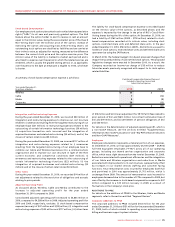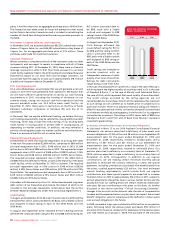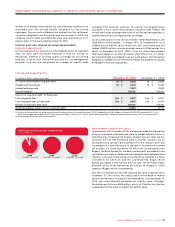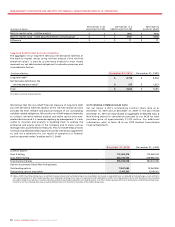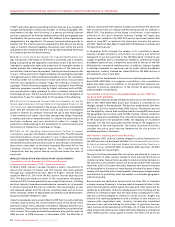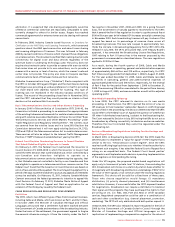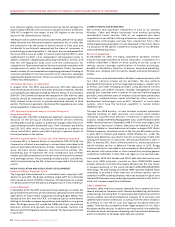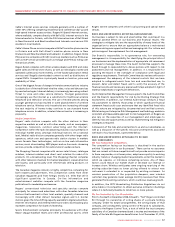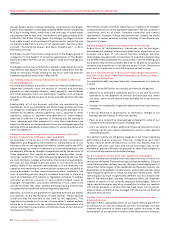Rogers 2010 Annual Report Download - page 44
Download and view the complete annual report
Please find page 44 of the 2010 Rogers annual report below. You can navigate through the pages in the report by either clicking on the pages listed below, or by using the keyword search tool below to find specific information within the annual report.
MANAGEMENT’S DISCUSSION AND ANALYSIS OF FINANCIAL CONDITION AND RESULTS OF OPERATIONS
48 ROGERS COMMUNICATIONS INC. 2010 ANNUAL REPORT
RCI’s senior unsecured debt to
be BBB, each with a Stable
outlook and assigned its BBB
rating to each of the 2040 Notes
and the 2020 Notes.
In August and September 2010,
Fitch Ratings affirmed the
issuer default rating for RCI to
be BBB and the rating for RCI’s
senior unsecured debt to be
BBB, each with a Stable outlook
and assigned its BBB rating to
each of the 2040 Notes and the
2020 Notes.
Credit ratings are intended to
provide investors with an
independent measure of credit
quality of an issue of securities.
Ratings for debt instruments
range along a scale from AAA,
in the case of Standard & Poor’s and Fitch, or Aaa in the case of Moody’s,
which represent the highest quality of securities rated, to D, in the case
of Standard & Poor’s, C, in the case of Moody’s and Substantial Risk in
the case of Fitch, which represent the lowest quality of securities rated.
The credit ratings accorded by the rating agencies are not
recommendations to purchase, hold or sell the rated securities inasmuch
as such ratings do not comment as to market price or suitability for a
particular investor. There is no assurance that any rating will remain in
effect for any given period of time, or that any rating will not be revised
or withdrawn entirely by a rating agency in the future if in its judgment
circumstances so warrant. The ratings on RCI’s senior debt of BBB from
Standard & Poor’s and Fitch and of Baa2 from Moody’s represent
investment grade ratings.
Deficiency of Pension Plan Assets Over Accrued Obligations
As disclosed in Note 17 to our 2010 Audited Consolidated Financial
Statements, our pension plans had a deficiency of plan assets over
accrued obligations of $152 million and $8 million at our September30
measurement date for the years ended December 31, 2010 and
December 31, 2009, respectively, related to funded plans, and a
deficiency of $37 million and $31 million at our September 30
measurement date for the years ended December 31, 2010 and
December 31, 2009, respectively, related to unfunded plans. Our
pension plans had a deficiency on a solvency basis at December 31,
2009, and are expected to have a deficiency on a solvency basis at
December 31, 2010. Consequently, in addition to our regular
contributions, we are making certain minimum monthly special
payments to eliminate the solvency deficiency. In 2010, the special
payments, including contributions associated with benefits paid from
the plans, totalled approximately $33 million. Our total estimated
annual funding requirements, which include both our regular
contributions and these special payments, are expected to increase
from $61 million in 2010 to approximately $70 million in 2011, subject to
annual adjustments thereafter, due to various market factors and the
assumption that our staffing levels will remain relatively stable year-
over-year. We are contributing to the plans on this basis. As further
discussed in the section entitled “Critical Accounting Estimates”,
changes in factors such as the discount rate, the rate of compensation
increase and the expected return on plan assets can impact the accrued
benefit obligation, pension expense and the deficiency of plan assets
over accrued obligations in the future.
In 2009, we made a lump-sum contribution of $61 million to our pension
plans, following which the pension plans purchased $172 million of
annuities from insurance companies for employees in the pension plans
who had retired as of January 1, 2009. The purchase of the annuities
party, 1.4 million shares for an aggregate purchase price of $45 million.
The transaction was made under an issuer bid exemption order issued
by the Ontario Securities Commission and is included in calculating the
number of Class B Non-Voting shares that we may purchase pursuant to
the NCIB.
Investment in Cogeco Cable Inc. and Cogeco Inc.
In November 2010, we acquired additional 892,250 subordinate voting
shares of Cogeco Cable Inc. and 946,090 subordinate voting shares of
Cogeco Inc. for an aggregate purchase price of $75 million. These
purchases were made for investment purposes.
Covenant Compliance
We are currently in compliance with all of the covenants under our debt
instruments, and we expect to remain in compliance with all of these
covenants during 2011. At December 31, 2010, there were no financial
leverage covenants in effect other than those pursuant to our bank
credit facility (see Note 14(a) to the 2010 Audited Consolidated Financial
Statements). Based on our most restrictive leverage covenants, we
would have had the capacity to issue up to approximately $18.1 billion
of additional long-term debt at December 31, 2010.
2011 Cash Requirements
On a consolidated basis, we anticipate that we will generate a net cash
surplus in 2011 from cash generated from operations. We expect that
we will have sufficient capital resources to satisfy our cash funding
requirements in 2011, including the funding of dividends on our
common shares, taking into account cash from operations and the
amount available under our $2.4 billion bank credit facility. At
December 31, 2010, there were no restrictions on the flow of funds
between subsidiary companies or between RCI and any of its
subsidiaries.
In the event that we require additional funding, we believe that any
such funding requirements may be satisfied by issuing additional debt
financing, which may include the restructuring of our existing bank
credit facility or issuing public or private debt or issuing equity, all
depending on market conditions. In addition, we may refinance a
portion of existing debt subject to market conditions and other factors.
There is no assurance that this will or can be done.
Required Principal Repayments
At December 31, 2010, the required repayments on all long-term debt
in the next five years totalled $3,084 million, comprised of $816 million
principal repayments due in 2012, $348 million due in 2013, $1,094
million due in 2014 and $826 million due in 2015. The required principal
repaymentsduein2012consistof$468million(US$470million)7.25%
SeniorNotesand$348million(US$350million)7.875%SeniorNotes.
The required principal repayment due in 2013 is the $348 million
(US$350million)6.25%SeniorNotes,aswellasthematurityofthebank
credit facility, which at December 31, 2010 is undrawn. The required
principal repayments due in 2014 consist of $348 million (US$350
million)5.50%SeniorNotesand$746million(US$750million)6.375%
Senior Notes. The required principal repayments due in 2015 consist of
$279 million(US$280million)6.75% Senior Notes and$547million
(US$550million)7.50%SeniorNotes.
Coincident with the maturity of our U.S. dollar-denominated long-term
debt, certain of our Derivatives also mature, the impact of which is not
included in the principal repayments noted above (See the section
entitled “Material Obligations Under Firm Contractual Agreements”).
Credit Ratings
In August and September 2010, Moody’s Investors Service affirmed the
rating for RCI’s senior unsecured debt to be Baa2, with a Stable outlook
and assigned its Baa2 rating to each of the 2040 Notes and the
2020 Notes.
In August and September 2010, Standard & Poor’s Ratings Services
affirmed the corporate credit rating for RCI to be BBB and the rating for
20102009
2008
2009
200
8
201
0
7.0x6.8x7.1x
RATIO OF ADJUSTED OPERATING
PROFIT TO INTEREST


